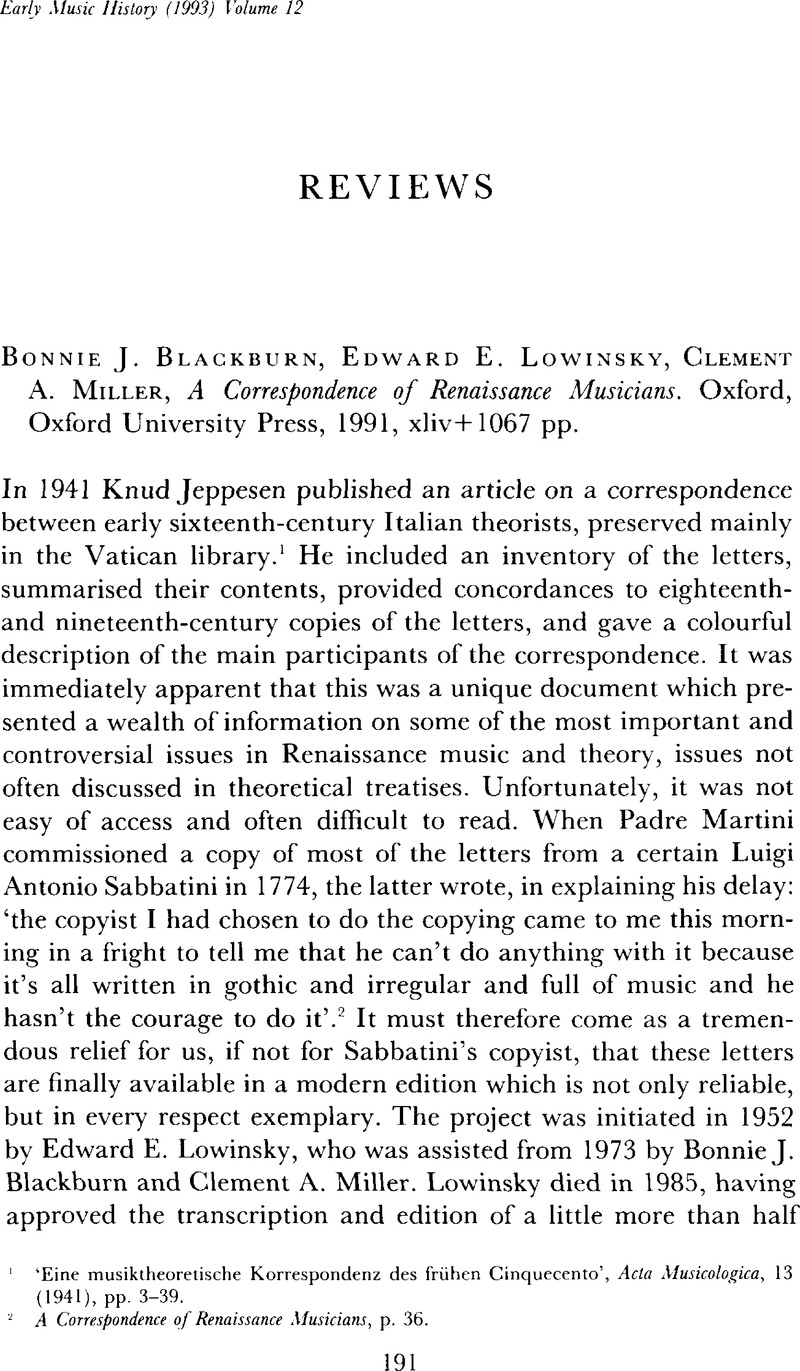No CrossRef data available.
Published online by Cambridge University Press: 05 December 2008

1 ‘Eine musiktheoretische Korrespondenz des frühen Cinquecento’, Acta Musicologica, 13 (1941), pp. 3–39.CrossRefGoogle Scholar
2 A Correspondence of Renaissance Musicians, p. 36.Google Scholar
3 He wrote a long treatise entitled Tractato di musica di Giovanni Spataro musico bolognese nel quale si tracta de la perfectione de la sesqualtera producta in la musica mensurala exercitate (Venice, 1531).Google Scholar
4 Venice, 1540.
5 A Correspondence, p. 412. All quotations are from the condensed English translations of the letters.Google Scholar
6 A Correspondence, p. 663.Google Scholar
7 A Correspondence, p. 662.Google Scholar
8 Even though Spataro expressly allowed Aaron to publish his now lost chart under his (Aaron's) name, I believe Lowinsky may be rash to conclude from this that Spataro was the author of Aaron's pamphlet ( A Correspondence, pp. 438–9).Google Scholar It is more likely that Aaron simply revised the chart himself when he received Spataro's letter. In his congratulatory letter of 24 October 1531 (pp. 433–8), Spataro never mentioned that he himself wrote the pamphlet, as he would surely have done, given his vanity, were he the author. The letter sounds more like that of a theorist who is happy that a colleague has finally come round to his point of view.
9 A Correspondence, p. 956.Google Scholar
10 A Correspondence, pp. 364–5.Google Scholar
11 See, for example, his discussion in Proportionate musices, in Opera theoretica, ed. Seay, A., Corpus Scriptorum de Musica 22 ([Rome], 1975–1978), IIa, pp. 14 and 49–50.Google Scholar
12 A Correspondence, p. 599.Google Scholar
13 See the detailed bibliography given at the end of A Correspondence.
14 ‘A Sample Problem of Musica ficta: Willaert's, Pater noster’, in Studies in Music History: Essays for Oliver Strunk, ed. Powers, H. (Princeton, 1968), pp. 161–82.Google Scholar
15 Musica Ficta: Theories of Accidental Inflections in Vocal Polyphony from Marchetta da Padova to Gioseffo Zarlino (Cambridge, 1987).Google Scholar
16 See also Chailley, J., ‘Tabula compositoriae’, Acta Musicologica, 51 (1979), 51–4. Chailley describes a slate from the early sixteenth century found in France.Google Scholar
17 Smith, D. E., Rara arithmetica (Boston, 1908), p. 13.Google Scholar
18 See my Mensuration and Proportion Signs: Origins and Evolution (Oxford, 1993), pp. 56-7 and 81–2.Google Scholar
19 ‘Ma se nel principio di ciascuna particola di ciascuno canto fusse segnato questo segno C, et poi in processu questo O, el quale non è diverso quantum ad mensuram di questo C, se non in quanto alia perfectione della breve, dico che allhora la proportione, la quale sarà segnata immediate appresso al secundo segno, porrà torre la sua misura così dal primo segno come dal secundo, perché tutti a duoi i segni sono simili et equali in misura, ma diversi di valore.’ A Correspondence, p. 806.Google Scholar
20 A Correspondence, pp. 755–6 and 753.Google Scholar
21 See my Mensuration and Proportion Signs, pp. 187–95.Google Scholar
22 For a detailed discussion of the modus cum tempore signs see my Mensuration and Proportion Signs, pp. 20–3 and 148–59; see in particular pp. 153–4.Google Scholar
23 See my Mensuration and Proportion Signs, pp. 120–48.Google Scholar
24 A Correspondence, p. 535.Google Scholar
25 Sec, for example, A Correspondence, p. 225.Google Scholar
26 See Tropfke, J., Geschkhte der Elementarmathematik (4th edn, Berlin, 1980), p. 328.Google Scholar
27 The proportions which occur in Spataro's Missa Da pacem are: 9:2, 6:3, 1:18, 21:2, 6:1, 3:7. The piece is lost.
28 A Correspondence, pp. 221 and 225. For a detailed discussion of the relationship between the Rule of Three and rhythmic proportions, see also my Mensuration and Proportion Signs, pp. 198–210.Google Scholar
29 See Mensuration and Proportion Signs, pp. 205–7.Google Scholar
30 A Correspondence, p. 52.Google Scholar
31 For a fascinating description of the influence of commercial arithmetic on painting, see Baxandall, M., Painting and Experience in Fifteenth-Century Italy (Oxford, 1972), pp. 86ff.Google Scholar
32 See, in particular, Hermann, Hankel, Zur Geschichle der Mathematik im Altertum und Mittelalter (Leipzig, 1874; repr. Hildesheim, 1965), p. 353 Google Scholar, and Smith, , Rara arithmetica, pp. 81–2.Google Scholar
33 For an excellent discussion of the Golden Section and Fibonacci Series, see W. Keil, ‘Gibt es den Goldenen Schnitt in der Musik des 15. bis 19. Jahrhunderts? – Eine kritische Untersuchung rezenter Forschungen’, Augsburger Jahrbuch für Musikwissenschaft (1991), pp. 7–70 Google Scholar. Keil concludes that there is no reason to believe that either the Golden Section or the Fibonacci Series was ever used in music before Bartók.
34 Wittkower, R., Architectural Principles in the Age of Humanism (London, 1988), p. 97.Google Scholar
35 Peterson, R. G., ‘Critical Calculations: Measure and Symmetry in Literature’, PMLA 91 (1976), pp. 371ff.CrossRefGoogle Scholar